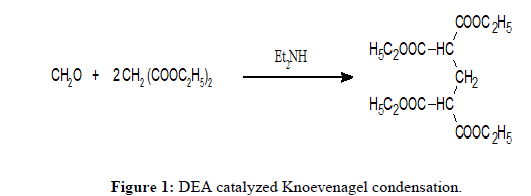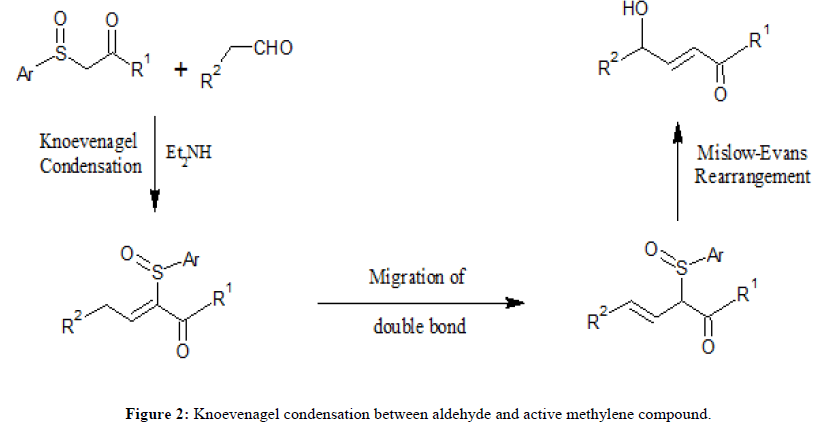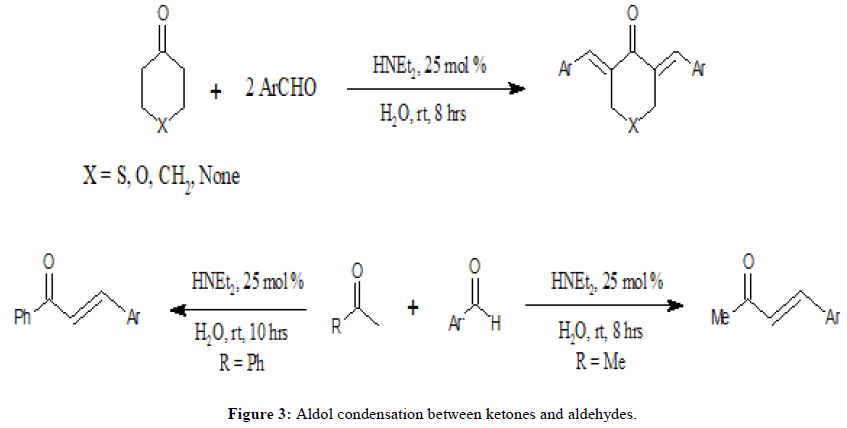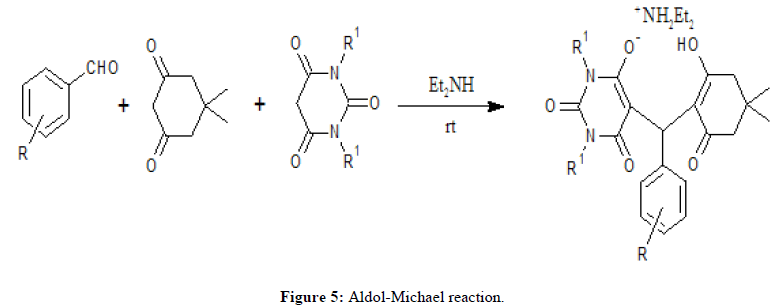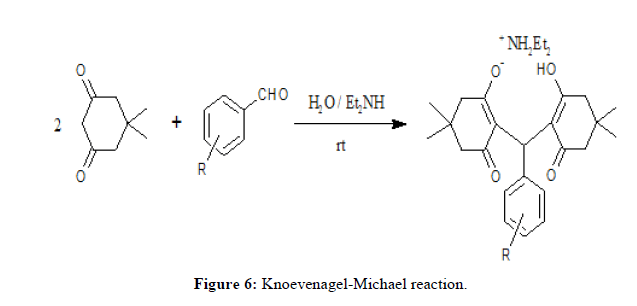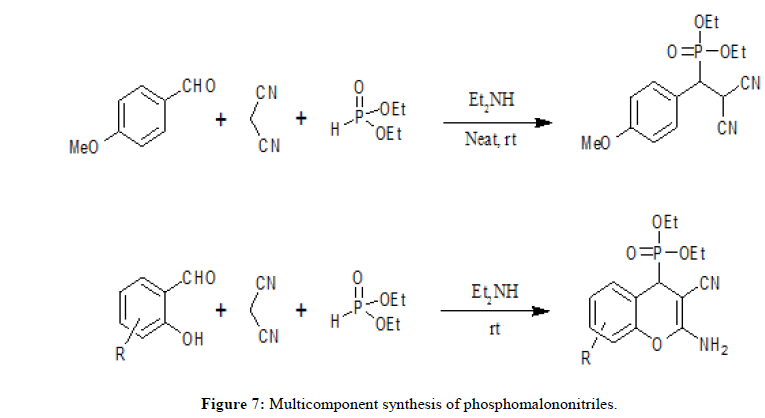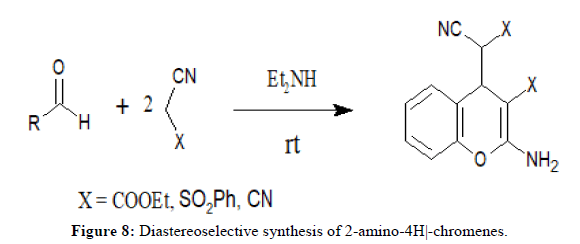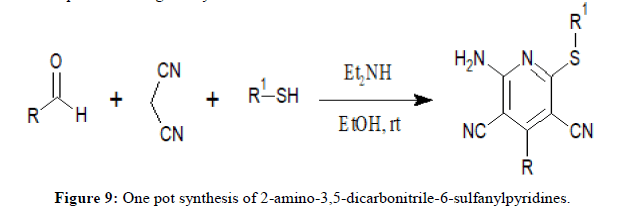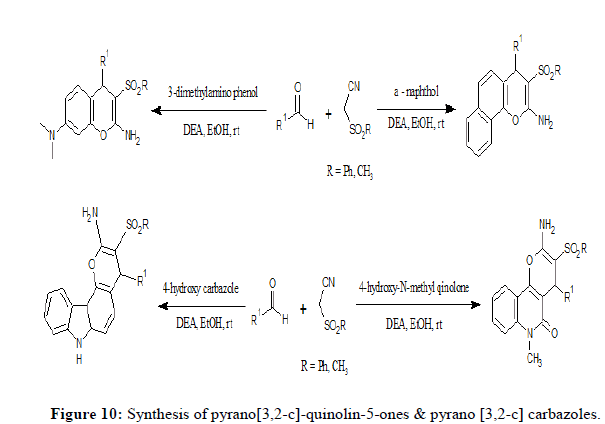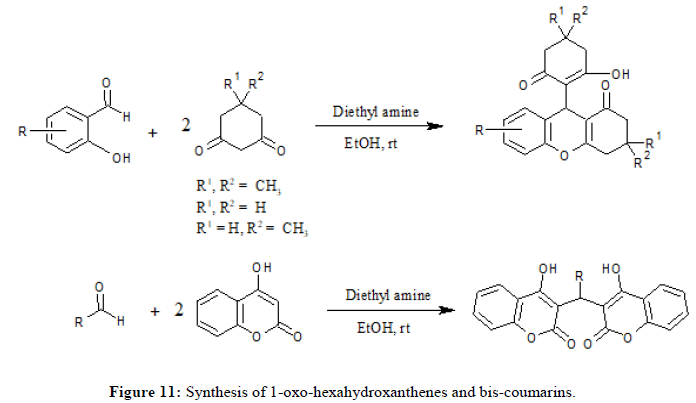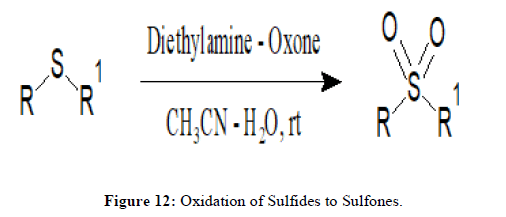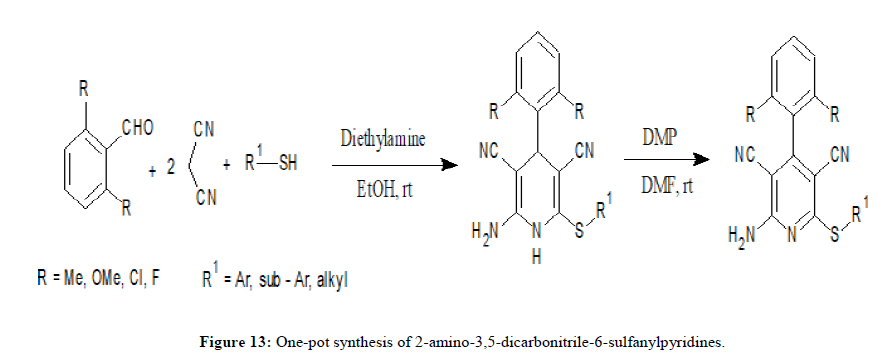Review Article - Der Pharma Chemica ( 2024) Volume 16, Issue 4
A Compendious Analysis of Diethylamine as an Organocatalyst
R. V. Kupwade*R. V. Kupwade, Department of Chemistry, Smt. Kasturbai Walchand College of Arts and Science, Affiliated to Shivaji University, Sangli, Kolhapur, India, Email: rv_kupwade@yahoo.co.in
Received: 16-Jul-2024, Manuscript No. DPC-24-141981; Editor assigned: 19-Jul-2024, Pre QC No. DPC-24-141981 (PQ); Reviewed: 26-Jul-2024, QC No. DPC-24-141981; Revised: 01-Aug-2024, Manuscript No. DPC-24-141981 (R); Published: 29-Aug-2024, DOI: 10.4172/0975- 413X.16.4.418-424
Abstract
Organocatalysts are the promising alternative for transition metal catalysts and hence become one of the hot research topics in advanced organic chemistry. Achievements by using piperidine, imidazole, DMAP, L-proline, brucine, strychnine, mcmillan's catalyst etc. have been mentioned in number of reports. However, the utility of diethylamine as a catalyst has been rarely investigated. Available reports disclose the potential of diethylamine to catalyze variety of organic transformations. Ambient reaction conditions, avoidance of conventional workups, ease of availability, ease of handling and cost effectiveness are the major traits of diethylamine as a catalyst.
Keywords
Organocatalysis; Diethylamine; Green; Inexpensive
Introduction
Considering the principles of “green chemistry” and the economics in organic synthesis, absence of metal in organocatalyst brings an undeniable advantage. Organocatalysts are low molecular weight organic molecules containing one or more hetero- atom and utilized in sub-stoichiometric quantities for variety of organic transformations. Organocatalysts have become the most affluent within the field of a catalytic regime. They provide many remarkable advantages in the field of synthetic chemistry. Organocatalysts, being an alternative to the prevalent transition metal catalyst, have received much attention in synthetic organic chemistry. Inexpensive, operationally easy to handle, insensitive to moisture and air, non-toxic, can be easily derived from natural resources etc. are the key attributes of organocatalyst. They can be lewis bases [1,2], bronsted bases [1,3,4] or bronsted acids [5] and may be achiral or chiral. Several excellent reviews have been communicated in this highly topical area.
Literature Review
The present review covers reported achievements by using diethylamine (Et2NH) as a catalyst. DEA (Diethylamine) is found to be very effective organic base that can be used as a catalyst in a range of organic transformations including simple condensation, derivatization, cyclization, oxidation and multicomponent reactions. It is less expensive and easily available in most of the organic laboratories. However, use of diethylamine as an organ catalyst had remained unexplored for several years and hence there are very scanty reports on its utility.
Diethylamine catalyzed reactions
In 1894 Emil Knoevenagel demonstrated for the first time the use of diethylamine as a catalyst for the reaction of formaldehyde with diethyl malonate to form bis adduct (Figure 1) [6].
In 2000 Nokami, et al., described a Knoevenagel reaction of aldehyde with sulfinyl activated methylene compounds in presence of diethylamine. The β-keto sulfoxides were treated with aldehydes and diethylamine in propanenitrile to give 4-hydroxy-2-alkenones. The reaction follows Knoevenagel and then Mislow Evans rearrangement path to furnish desired product. However, for this reaction diethylamine was used in stoichiometric amount with ratio 1:1 (Figure 2) [7].
Discussion
Abaee, et al., in 2009 have reported inexpensive, environmentally friendly and efficient protocol for aldol condensation of ketones with various aldehydes using diethylamine as catalyst under aqueous conditions. Condensation of heterocyclic, homocyclic as well as non-cyclic ketones with variety of aldehydes was executed successfully. High yield of product, operational simplicity and reuse of reaction medium are the incremental advantages of this protocol (Figure 3) [8].
In 2010 Abaee, et al., explored diethylamine to offer another simple and ecobenign procedure for oxidative synthesis of homodisulfides under ambient condition. In this investigation they demonstrated utility of diethylamine for rapid and efficient conversion of thiols to their respective homodisulfides using ambient air under aqueous conditions (Figure 4) [9].
Barkat, et al., in 2014 reported expeditious method for the synthesis of zwitterion-condensed products via a three component Aldol-Michael reaction of aromatic aldehyde, barbituric acid and dimedone using aqueous diethylamine medium. Short reaction time, high yields and clean synthetic procedure are the notable features of this protocol (Figure 5) [10].
Tandem Knoevenagel–Michael reaction in aqueous diethylamine medium for one-pot synthesis of bis-dimedon derivatives has been established by Al-Majid, et al. [11]. Short reaction time and simple purification method are the significant features of this protocol (Figure 6).
For the first time Kulkarni, et al., demonstrated multicomponent synthesis of β-phosphonomalononitriles using diethylamine as a catalyst under solvent-free condition. Usability of the diethylamine catalyst is extended for the synthesis of diethyl (2-amino-3-cyano-4Hchromen-4-yl) phosphonic acid esters (Figure 7) [12]. Both greener protocols operate at ambient temperature with operational simplicity, easy work-up procedures and excellent yields of the products.
In continuation with previous study on efficacy of diethylamine as catalyst, Kulkarni et al. have reported diastereoselective synthesis of medicinally privileged 2-amino-4H-chromenes by pseudo three-component condensation between salicylaldehyde and three different C–H acids (Figure 8) [13]. Ambient temperature and avoidance of conventional work-up are the key attributes of this protocol.
The use of diethylamine as catalyst in the one pot synthesis of medicinally privileged 2-amino-3,5-dicarbonitrile-6-sulfanylpyridines at ambient temperature was reported by Desai, et al., (Figure 9) [14]. Ambient temperature and avoidance of conventional work-up as well as purification procedure qualify this cost-effective protocol for “green synthesis.”
Based on the noteworthy observations in pseudo three-component condensation between salicylaldehyde and C–H acid (Stoichiometric ratio1:2) for synthesis of 2-amino-4H-chromenes, Pandit, et al. employed diethylamine for real three component condensation between aromatic aldehyde and two different C-H acids. They have successfully developed an enviro-economic protocol for the synthesis of 2-amino-3-aryl (or alkyl) sulphonyl- 4H-chromenes using diethylamine as a catalyst. This report highlights the choice of phenyl or alkylsulfonyl acetonitrile as one of the C-H acid in combination with 3-dimethylaminophenol and α-naphthol as second C-H acid. In same report potential of diethylamine has been successfully extended towards the synthesis of pyrano[3,2-c]-quinolin-5-ones as well as pyrano [3,2-c] carbazoles (Figure 10) [15].
Kupwade, et al., have reported very convenient and efficient method for the synthesis of 1-oxo-hexahydroxanthenes and bis-coumarins using diethylamine as a catalyst (Figure 11) [16]. Circumvention of usual work-up as well as purification procedure is the noteworthy advantages of this energy-efficient protocol.
A distinguishing application of diethylamine was investigated by Kupwade, et al., (Figure 12) for the oxidation of sulfides to sulfones using diethylamine-Oxone as an unprecedented catalyst-oxidant combination [17]. This report encompasses diethylamine catalysed eco-benign, chemoselective, chromatography-free and scalable protocol for synthesis of sulfones using Oxone as an oxidant.
Diethylamine Dess-Martin periodinane has been demonstrated as an efficient catalyst- oxidant combination in a sequential, one-pot synthesis of difficult to access 2-amino-3,5-dicarbonitrile-6-sulfanylpyridines by Kupwade, et al., (Figure 13) [18]. The reaction proceeds via a pseudo-four component reaction between 2,6-disubstituted benzaldehydes, malononitrile and thiols. Ambient reaction conditions, excellent yields and total avoidance of conventional isolation as well as purification are the noteworthy merits of this developed protocol.
Conclusion
In spite of commercial availability at extremely low cost diethylamine was rarely explored as a catalyst, the reason behind this must be its low boiling point. On basicity scale (pKb value) diethylamine is very close to triethylamine as well as piperidine but due to low boiling point it cannot be used at elevated temperature. However, our research group disclosed the significant utility of diethylamine for variety of synthetic conversions. This succinct review highlights on versatility and pervasiveness of diethylamine as organocatalyst. Low cost, ease of handling, ease of removal from waste streams and resourceful synthetic applications are the prominent attributes of diethylamine as a catalyst.
References
- Jangid DK. Currt Green Chem. 2020; 7(2): p. 146-162.
- Denmark SE, Beutner GL. Angew Chem Int Ed. 2008; 47(9): p. 1560-1638.
[Crossref] [Google Scholar] [PubMed]
- Boddu SK, Ur Rehman N, Mohanta TK, et al. Green chem lett rev. 2022; 15(3): p. 765-795.
- Ting A, Goss JM, McDougal NT, et al. Asymmetric Organocatalysis. 2009: p. 201-232.
[Crossref] [Google Scholar] [PubMed]
- Akiyama T, Itoh J, Fuchibe K. Adv Synth Catal. 2006; 348(9): p. 999-1010.
- Knoevenagel E. Rep German Chem Soc. 1894; 27(2): p. 2345-2346.
- Nokami J, Kataoka K, Shiraishi K, et al. J Org Chem. 2001; 66(4): p. 1228-1232.
[Crossref] [Google Scholar] [PubMed]
- Abaee MS, Mojtahedi MM, Forghani S, et al. J Braz Chem Soc. 2009; 20: p. 1895-1900.
- Abaee MS, Mojtahedi MM, Navidipoor S. Syn Comm. 2010; 41(2): p. 170-176.
- Barakat A, Al-Majid AM, Al-Ghamdi AM, et al. Chem Cent J. 2014;8: p. 1-9.
[Crossref] [Google Scholar] [PubMed]
- Al-Majid AM, Islam MS, Barakat A, et al. Arab J Chem. 2017; 10(2): p. 185-193.
- Kulkarni MA, Pandurangi VR, Desai UV, et al. C R Chim. 2012; 15(9): p. 745-752.
- Kulkarni MA, Pandit KS, Desai UV, et al. C R Chim. 2013; 16(8): p. 689-695.
- Desai UV, Kulkarni MA, Pandit KS, et al. Green Chem Lett Rev. 2014; 7(3): p. 228-235.
- Pandit KS, Kupwade RV, Chavan PV,et al. ACS Sustain Chem Eng. 2016; 4(6): p. 3450-3464.
- Kupwade RV, Pandit KS, Desai UV, et al. Res Chem Intermed. 2001; 42: p. 6313-6325.
- Kupwade RV, Khot SS, Lad UP, et al. Res Chem Intermed. 2017; 43: p. 6875-6888.
- Kupwade RV, Khot SS, Kulkarni MA, et al. RSC Adv. 2017; 7(62): p. 38877-38883.

